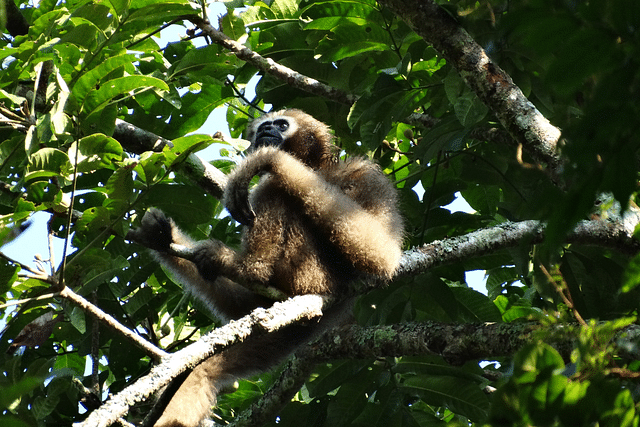News Headlines
Concerns Raised Over Conservation Status Of India's Only Ape Species

A western hoolock gibbon female in Hollongapar Gibbon Wildlife Sanctuary, Assam (Photo: Miraj Hussain/Wikimedia Commons)
The conservation status of India's only ape was a cause for concern at a recent global event on gibbons in China.
Gibbons are the smallest and fastest of all apes. The hoolock gibbon, unique to India's northeast, is one of 20 species of gibbons found in tropical and subtropical forests in Southeast Asia.
Unfortunately, all 20 species of gibbons are at a high risk of extinction, including the hoolock gibbon. The estimated population of hoolock gibbons is 12,000, making their conservation a pressing issue.
The Global Gibbon Network (GGN) discussed these alarming statistics and the decline in gibbon distribution and populations during their meeting in China's Hainan province, as reported by The Hindu.
Gibbons are highly intelligent creatures with distinct personalities and strong family bonds, similar to other apes. Since 1900, gibbon distribution and populations have drastically decreased, leaving only small populations in tropical rainforests.
The GGN emphasised the urgent need for conservation efforts to protect all 20 gibbon species.
The primary threat to the hoolock gibbon is the deforestation caused by infrastructure projects.
Gibbons are known for their energetic vocal displays and were initially found in Assam.
For many years, zoologists believed that there were two species of hoolock gibbons in the northeast region of India — the eastern and western hoolock gibbons.
In 2021, a study conducted by the Centre for Cellular and Molecular Biology (CCMB) in Hyderabad provided evidence through genetic analysis that there is actually only one species of gibbon in India.
According to the Red List maintained by the International Union for Conservation of Nature (IUCN), the western hoolock gibbon is classified as endangered and the eastern hoolock gibbon as vulnerable.
Support Swarajya's 50 Ground Reports Project & Sponsor A Story
Every general election Swarajya does a 50 ground reports project.
Aimed only at serious readers and those who appreciate the nuances of political undercurrents, the project provides a sense of India's electoral landscape. As you know, these reports are produced after considerable investment of travel, time and effort on the ground.
This time too we've kicked off the project in style and have covered over 30 constituencies already. If you're someone who appreciates such work and have enjoyed our coverage please consider sponsoring a ground report for just Rs 2999 to Rs 19,999 - it goes a long way in helping us produce more quality reportage.
You can also back this project by becoming a subscriber for as little as Rs 999 - so do click on this links and choose a plan that suits you and back us.
Click below to contribute.
Latest